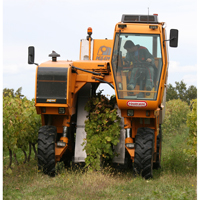David on Technical Topics – The Vines
The chalky soil of the Charente, particularly in the Champagnes, is not unique since it is also a notable feature of the Champagne growing region (it is the ‘Champenoise’ who stole the name for their famous drink). The chalk provides excellent drainage and can also store substantial quantities of water which the vine roots can easily access. Crucially too, chalky soil, which provides very few nutrients, improves the quality of the grapes.
Whilst the ‘terroir’ in the Cognac region can change, the grape varieties used have changed only twice in the last four centuries. In the 17th Century the region was largely planted with Balzac. It had some important characteristics in that it was a good cropping variety and didn’t bud too early which avoided any potential spring frosts. By the turn of the 19th Century the Folle, or Folle Blanche as we know it today, and to a lesser extent the Colombard, had largely replaced the Balzac. Both of these varieties had already been grown in the Armagnac region with considerable success.
By the mid-19th Century demand for cognac had grown considerably and there was increasing pressure on the vineyards to produce more wine. This increased demand had a detrimental effect on the vines as their roots weakened and they became susceptible to the tiny, yellow, louse, Phylloxera Vastatrix. The Phylloxera outbreak devastated European vineyards around 1870 – 1875 and most of the cognac vines died. It took twenty years before a new rootstock, principally grafted with an Italian grape variety, known as the Trebbiano Toscana from the hills of the Emilia Romagna, was imported from America. The grape became known locally as the St Emelion du Charente but is better known today as the Ugni Blanc. This green acidic grape, which produces a low alcohol wine with little character, is normally used as a base wine for blending.
After the Phylloxera the Cognaçaise started to plant their new vines in rows rather than the uneven bush planting methods used before. This new method of planting produced a greater concentration of vines per hectare and more recently has enabled the use of machines to pick the grapes. With careful pruning the vines, which grow on wires, can grow up to 1.8 metres high though are usually between 1.2 – 1.5 metres. The vines are still kept relatively low in order to take advantage of the reflection of the heat from the chalky soil. In some cases grapes at the top of a vine can take a week longer to ripen than those close to the ground.
Machine harvesting is now used in virtually every vineyard and has become well adapted to the modern methods of viniculture. Vine planting is controlled at a maximum of 3000 per hectare but this is a substantial number. Improvements in harvesting have increased the amount that a hectare can now produce. This was demonstrated a few years ago when the Chinese demand for cognac was high. As a consequence the BNIC changed the maximum permitted allowance to 10 hectolitres of pure alcohol per hectare (hl/ha) and many vineyards achieved this – only a few years earlier they had been struggling to produce 8.5 hl/ha.
However, as with all harvesting the weather is the biggest influencing factor. Whilst in most cases the Charente ‘terroir’ holds good, extremes of rain and sun can either delay the harvest or produce too much sweetness in the grapes creating a ‘pappiness’ in some cognacs. Cognac viniculture has come a long way in a relatively short period. If we can find Grande Champagne cognacs in 80 – 100 years’ time that were made in the last 20 years, they will be the true Siècle d’Or.

